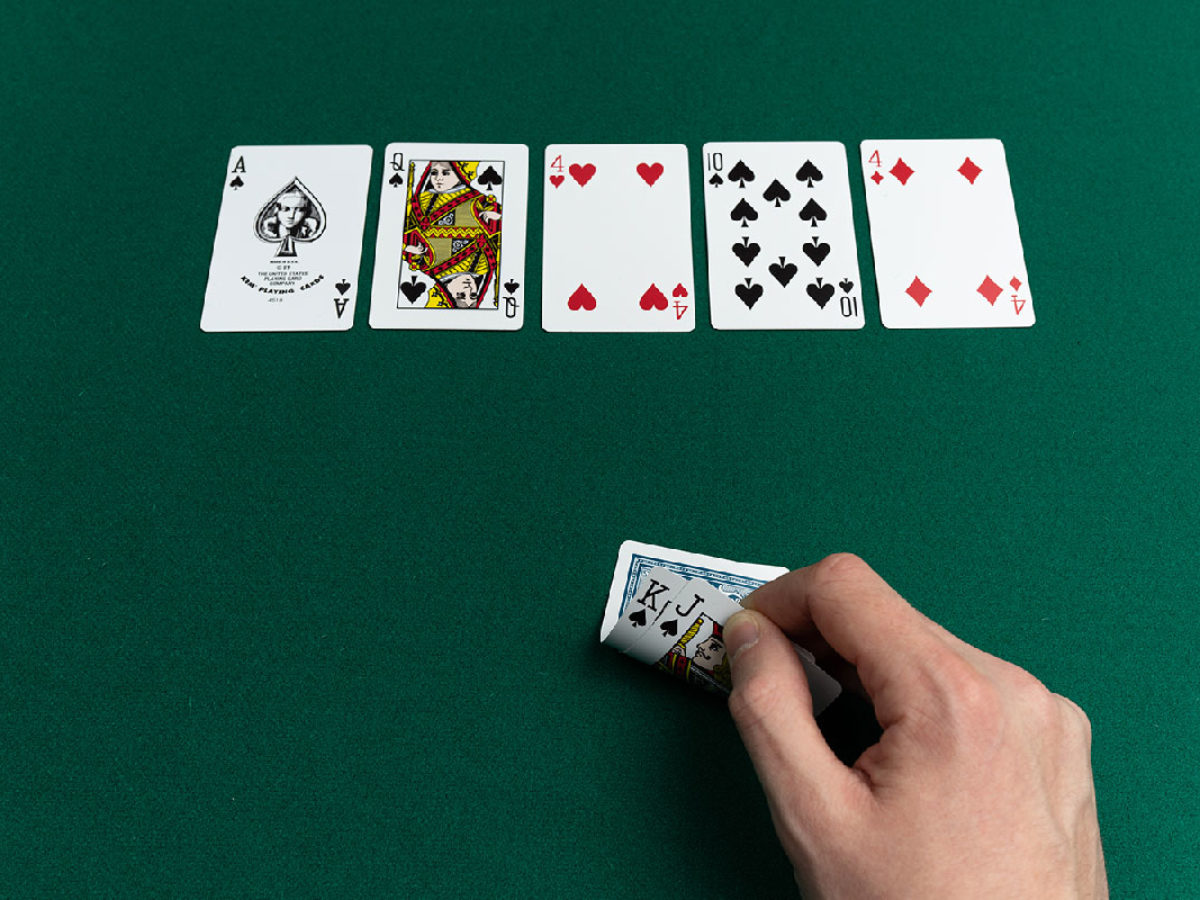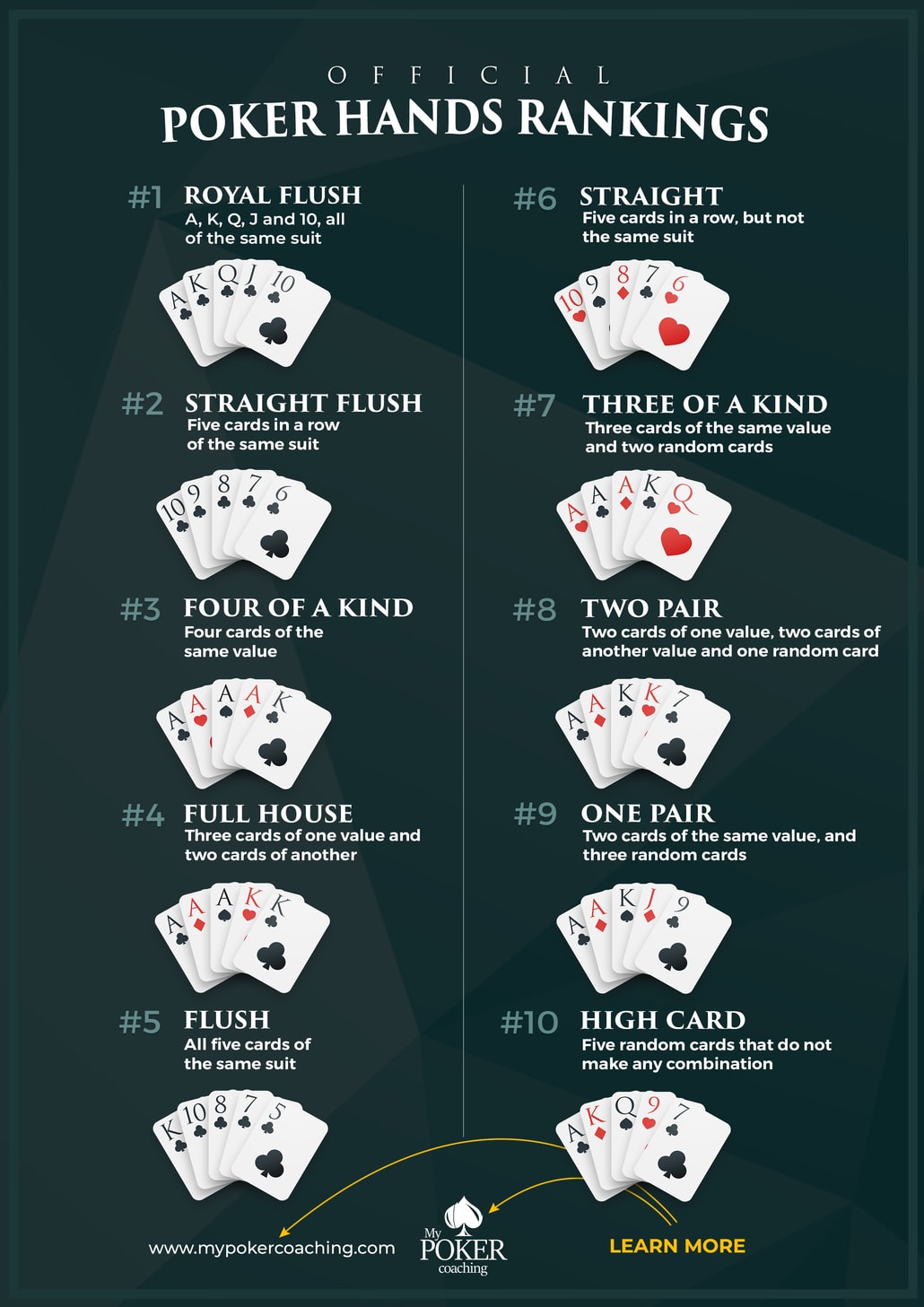What Is The Ranking Of Poker Hands
Use the list of poker hand rankings below to instantly know what beats what in poker for any particular hand you might be dealing with. Commit this poker hand ranking list into memory now and if you need it, print it out (there is a button on the right bottom). Knowing the correct poker hand ranking is crucial to begin making a winning poker hand immediately. Once you can get a grip on a hand ranking system, then you will know what kind of bets you should be making in any writing you might be dealing with, so you can increase your bankroll and win more poker tournaments.

Poker hands fall into one of ten categories. The highest is a royal flush, followed by a straight flush, then four of a kind, a full house, a flush, a straight, three of a kind, two pair, one pair, and finally a high card. There are 52 cards in a deck, divided into four suits of 13 ranks each. The suits are all of equal value - no suit is higher than any other suit. In Poker, the Ace is the highest card and the 2 card (Deuce) is the lowest. However, the Ace can also be used as a low card, with the value of 1. Use the OFFICIAL poker hand rankings to know what beats what in poker. Download the PDF list of poker hands. Here is a list of the Texas Hold'em Poker Hand rankings for you to see which are the best hands in order. Poker Hand Rankings - Best Poker Hands in Order Find all poker hands ranked from best to worst. Use our poker hands reference chart until you are 100% certain of hand rankings. Poker hands from strongest to weakest. Royal Flush: Five card sequence from 10 to the Ace in the same suit (10,J,Q,K,A). Straight Flush: Any five card sequence in the same suit. 8,9,10,J,Q and A, 2,3,4,5 of same suit). Standard Poker Hand Ranking There are 52 cards in the pack, and the ranking of the individual cards, from high to low, is ace, king, queen, jack, 10, 9, 8, 7, 6, 5, 4, 3, 2.
There are three types of poker hand rankings: pre-flop, post-flop, and flop. The pre-flop hands are the highest valued cards in the player’s hand before the turn, pre-flop, flop, post-flop. Post-flop hands are the second highest valued cards in the player’s hand after the turn. High card hands rank after the loss and before the turn, also known as post position, and they are valued higher than the flop position.

To get a good idea of what beats what in poker for each hand you are dealing with, we need to go over the poker hand rankings charts. poker The best way to remember what hands beat is by placing which hands have the highest hands at the end of the turn. If you can memorize that quickly, you have a leg up on the competition because some players are known to be weak early in the game, but they make up for it later in the game. You will want to memorize pre-flop hands, post-flop hands, and flop hands and keep them in front of your eyes at all times when you play poker.

What makes what beats what in poker even more impressive is whether the hands hit the other two in consecutive games. The two highest hands usually beat the two lowest hands in successive games. In the multi-game play, the highest kicker is generally worth at least three to four points against the next highest kicker in a two-game set. So if two players have a hand that is worth three to four points in pre-flop money, they are worth two to three points each in post-flop action. This makes what beats what in poker even more interesting because there are so many possibilities for each player.
For example, let’s say that Jack and Jill are both playing strong hands in pre-flop action. Jack has a strong hand pre-flop and then bets out raising his pre-flop hand to ten big money. Jill calls and folds on the flop and then bets out again, raising her pre-flop hand to fourteen. Now we will wait for Jack to fold or call after both raises.
What beats what in poker hand rankings is simply consistency. If a player is consistent with raising and betting out large hands and calling or folding weak hands consistently, their hand ranking will be compatible. However, sometimes this is not enough, and the player must study the game and analyze where their low draws and poor decisions come from. Many times these problems can be solved by gaining a better understanding of the general poker rules.
Most Commonly Asked Poker Questions
What Is The Ranking Of Poker Hands Play
Not sure what beats a full house or what a straight can beat? Here are the answers to the most commonly-asked poker questions this side of the Strip.
Does a flush beat a full house?
No. A full house beats a flush in the standard poker hand rankings. The odds against making a full house in a game of Texas Hold’em are about 36-to-1, while the odds against making a flush are 32-to-1. The full house is a more rare hand and beats a flush.
Does a flush beat a straight?

Yes. Using the standard poker hand rankings, a flush beats a straight, regardless of the strength of the straight. The odds against making a straight in Texas Hold’em are about 21-to-1, making it a more common hand than a flush (32-to-1 odds against).
Does a straight beat a full house?
No. The odds against making a full house in Texas Hold’em are about 36-to-1, while the odds against making a straight are about 21-to-1. Both are strong five-card hands, but a full house occurs less often than a straight. A full house beats a straight in the poker hand rankings.
Does three of a kind beat two pair?
Yes. Both three of a kind and two pair can make a lot of money in poker, but three of a kind is the best hand when it goes head to head with two pair. The odds against making three of a kind in Texas Hold’em is about 20-to-1, while the odds against making two pair is about 3-to-1.
Does three of a kind beat a straight?
No. The odds of making both of these hands are very close in a game of Texas Hold’em. The odds against making a straight are 20.6-to-1, while the odds against making three of a kind are 19.7-to-1. The straight comes about slightly less often, making it the winner against three of a kind in the poker hand rankings.
Does a flush beat three of a kind?
Yes. The battle of strong hands between a flush and three of a kind sees the flush as the stronger hand. The odds against making a flush in Texas Hold’em are about 32-to-1, with odds against making three of a kind at around 20-to-1.
Does a straight beat two pair?
Yes. The poker hand rankings dictate that a straight is a stronger hand than two pair. The straight occurs with about 21-to-1 odds against in Texas Hold’em, while the odds against making two pair stand at about 3-to-1.
Does four of a kind beat a full house?
Yes. Both four of a kind and a full house are among the strongest poker hands, but four of a kind is a much rarer holding. Texas Hold’em odds against making four of a kind are 594-to-1, while you have about 36-to-1 odds against making a full house.
Does three of a kind beat a flush?
Highest To Lowest Poker Hands
No. When the flush and three of a kind go head to head, the flush comes out as the best according to the poker hand rankings. The odds against making three of a kind sit around 20-to-1, with the odds against hitting a flush at 32-to-1.
Does a full house beat a straight in poker?

Yes. The full house comes in less often than a straight. In Texas Hold’em, the odds against drawing a full house are around 36-to-1, while the odds against making a straight are around 21-to-1.
What Is The Ranking Of Hands In Poker
Does a straight flush beat four of a kind?
What Is The Ranking Of Poker Hands Held
Yes. Four of a kind is an exceedingly rare hand in poker, but the straight flush is an even more elusive five-card hand. The odds against making a straight flush in Texas Hold’em is about 3,590-to-1, much rarer than four of a kind (594-to-1 odds against)